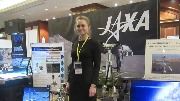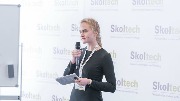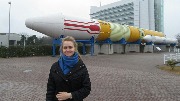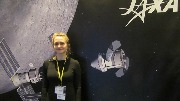The Path to the Stars Begins in MAI: the History of a Space Startup
Thus, the director for strategy and marketing development, Praveen Sankaran, also graduated from the Master’s degree program of the department 601 "Space systems and rocket science" under the guidance of Ph.D., associate professor Valery Panasenkov. A consultant for research and development at Easar is a postgraduate student and a researcher at the university Stanislav Freylekhman.
How to find your topic?
For Elena, everything began with the topic proposed to her by supervisor, associate professor Valery Panasenkov: a project aimed at exploring the launch capabilities for small spacecraft.
“We were dreamers, but we decided to become implementers,” - Elena described the decision to establish the space company “Easar”. Its unusual name goes back to the legendary figure from Celtic mythology of Ireland, the god of fire and action. – “This title inspires me.”
Now the company focuses on aerospace development, but has one project in the energy sector: reducing electricity consumption in the Moscow metro. Now the company “Easar” has received a patent for the launch system for the market of small spacecraft and is awaiting a patent for another invention - a system to deal with space debris.

3D printer on the Moon
In September of last year, MAI graduates began work aimed at the application of additive technologies on the surface of the natural satellite of the Earth. Elena's team considers this area to be very promising, opening up new opportunities for humanity.
“Additive technologies are already actively used today in the rocket and space industry,” - admitted Elena. – “3D printing is used in the manufacture of spacecraft. So, “Boeing” using these technologies produces modular satellites. All this allows you to reduce the cost of production, while increasing its operational characteristics.”
Since 2014, the International Space Station (ISS) has also operated 3D printers that allow astronauts to print the necessary parts if any parts fail in space. And this is critical for future flights, for example, to Mars. At the end of 2018, the first Russian 3D printer, designed for bio printing experiments in zero gravity, was delivered to the ISS.
Further implementation will contribute to a significant reduction in the cost of space missions and will make possible the study of deep space.
“For the formation of future settlements on the lunar surface, it is necessary to prepare appropriate conditions conducive to the development of the lunar infrastructure. These primary objects can be lunar spaceports, equipped with minimal, but necessary and sufficient resources for the first steps in exploration of the Earth’s satellite surface, ”- said Elena.
The first to fly to the Moon will be robots, moon rovers and other technical systems that will allow adapting aggressive environmental conditions. They will create conditions suitable for the life of living organisms, including man.

“The use of building 3D printing for the erection of structures on the surface of the Moon and Mars is precisely the area that the Easar team deals with,” - explained Elena. – “Our company is preparing to present its initiative at the Moon tech competition “The Moon Race”, which was announced by the Airbus concern in partnership with the European Space Agency, Blue Origin and other organizations. It aims to develop the technologies needed to create a sustainable base on the Moon. The result of the competition in 5 years will be the implementation of breakthrough projects on the surface of the satellite. Our project is aimed at preparing a "reference" point for these technical systems, equipped with the means and resources capable of supporting and ensuring their operability, but it is not yet possible to reveal the details of the project, since it participates in the competition.”
In the future, “Easar” can contribute to space exploration, since the presence of a base on a natural Earth satellite will definitely help in the implementation of difficult and long space missions.
Someone Must Clean the Stars
Among other areas that Elena deals with is the fight against space debris, which in the future could become a serious obstacle for further space exploration. As a space ecologist by first education, she could not pass by this problem: “In my family they joked that someone should “clean the stars”. But seriously - this problem should worry everyone on planet Earth.”
Since last August, the team has been carried out comprehensive research aimed at finding a technical solution for effectively combating space debris. After the system analysis was carried out, an innovative and economical way to fight the clogging of outer space was identified. A positive expert assessment of the proposed technical solution has already been received, and on December 14, 2018, a patent application has been filed. However, to obtain a patent it is not possible to give more details.

Space to People
The path to the stars begins with quite self earthly learning. Therefore, to promote the space industry among enthusiasts of all ages, “Easar” organizes educational tours to leading aerospace corporations and enterprises, such as State Corporation “Roscosmos”, JAXA (Japanese Space Agency), DLR Aerospace (German Aerospace Center), S.P. Korolev Rocket and Space Corporation “Energia” and other enterprises.
“The first weekly educational tour in Russia will be held in April of this year, during which people will visit PAO RSC Energia and receive training in the cosmonaut training program at the Gagarin Research & Test Cosmonaut Training Center,”- said Elena. – “Then, in June, children from India will visit the Japanese space agency - they showed up first when a tour to Japan was announced. In Japan, schoolchildren will visit two space centers, the Tanegashima Space Center (named the most beautiful cosmodrome in the world), have a master class with issuing certificates, and meet with the Japanese cosmonaut. We strive to ensure that both of these trips become a real event in the life of children and a starting point to the highest peaks.”
The starting point for Elena was MAI itself. Here are the roots of the promising developments of her company, the teachers for whom she is deeply grateful, many of her colleagues are MAI graduates. The company itself, like Elena, is clearly not going to stop at the existing plans. The aspiration up is laid in each MAI student during training, we expect new breakthrough technologies implemented by university graduates.





